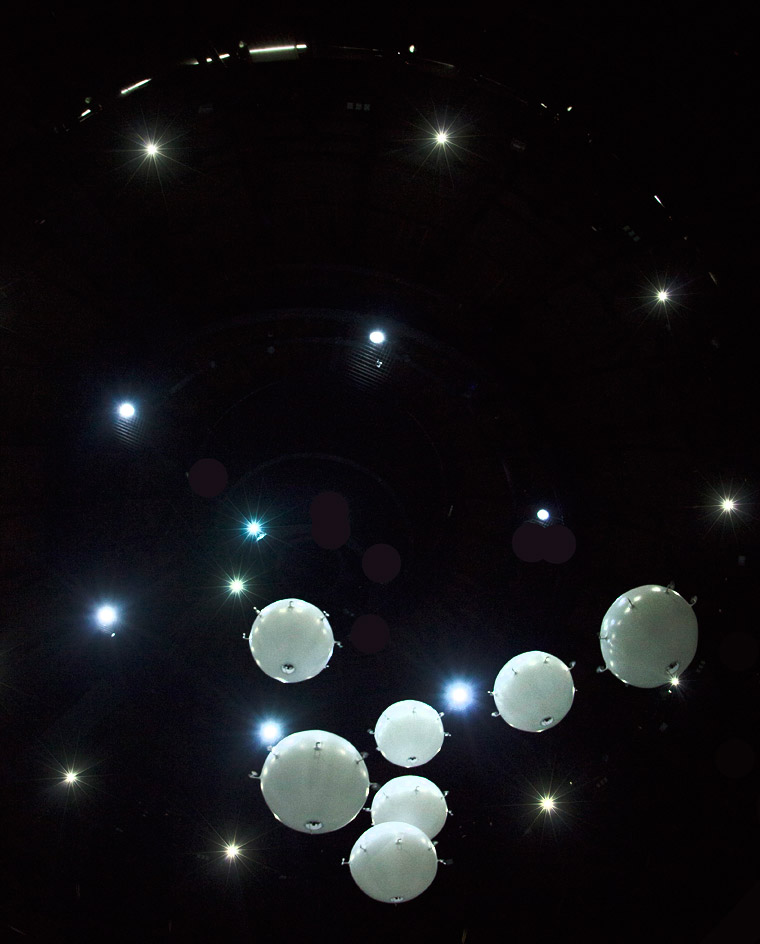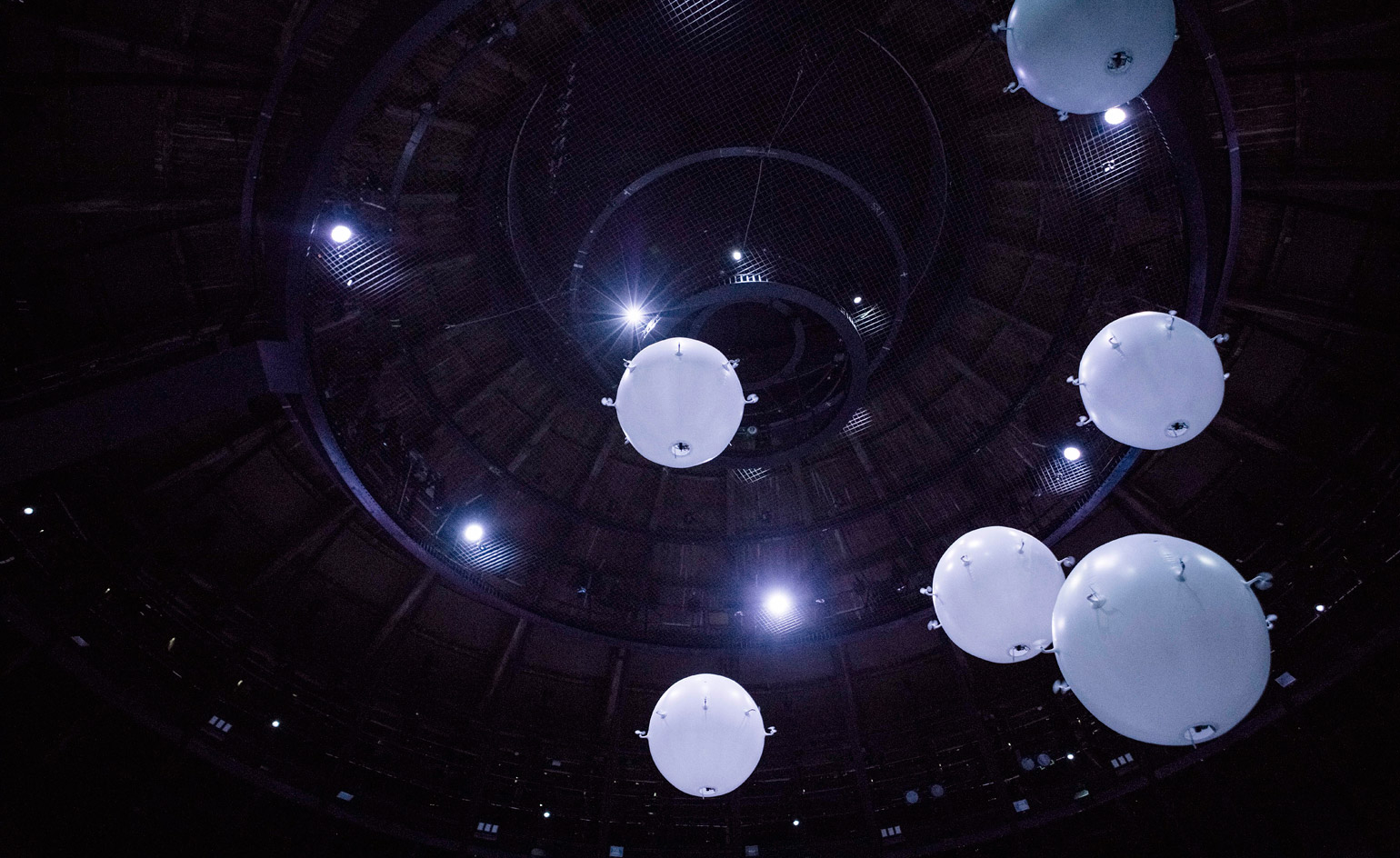Spheres of influence: Wayne McGregor dances the line between man and machine

‘There isn’t really an English word for what we have created. It's kind of an experience; a performance; a living artwork.’ So says Random International’s dramaturg Heloise Reynolds, of the practice’s latest installation, unveiled in London last week.
Staged in the echoing Roundhouse theatre, the art-meets-technology studio has designed seven helium-filled white globes that hover and swarm around the space on tiny propellers. In one moment, they’re pack-like, curious. In others, they’re inanimate, programmed, droning. ‘We’re trying to create a sense of otherness,’ says Random International co-founder Hannes Koch. ‘We want people to feel like aliens. We want to say, “This is how it feels to be intimately exposed to a very advanced organism.”’
Dreamt up in an unlikely industrial estate in Balham, where Random International’s engineers have spent the last five months buried under complex behavioural data maps, the spheres’ flocking behaviour is determined by generative algorithms built to resemble human characteristics. Able to react to their environment, the computer-controlled orbs select individuals from the audience to hone in on – swooping inquisitively towards them, or sinisterly mirroring their movements. In a landscape of driverless cars, digital butlers and ‘the robots are coming!’, these oddly familiar spheres pull at the tangled thread of what it means to be human in the age of AI.
Frequent Random International collaborator, choreographer Wayne McGregor, has long been fascinated by this ever-slimming intersection between man and machine. Through his futuristic staging and his boundary-defying collaborations, McGregor does more than walk the ‘uncanny valley’, he dances there.
As he has done here, engaging a troop of his dynamic studio dancers to perform underneath the hovering, human-like globes to an electronic score especially composed by Warp Records’ Mark Pritchard. The formidable likes of Edward Watson and Fukiko Takase look anonymous, painted with either a ‘+’ or ‘–’ symbol. They are human magnets, pulling together and pushing apart. The elemental dancers enter into a loose dialogue with the globes, staying low, as the orbs twist into lofty formations overhead.
The human and technological aspects of the exhibition interact seamlessly, a testament to the well-matched collaborators – despite the fact McGregor didn't know exactly how the installation would look and act until it was installed. ‘I got it conceptually, and that was enough,’ he explains.
It helps that the collaborators are ‘on the same page aesthetically’. Instead of shunning technology as a clinical device, both McGregor and Random International use it as a theatrical tool to evoke emotion. ‘I think technology can make you feel something,’ McGregor continues. ‘It’s visceral. It can help the audience to embody a performance.’
That’s exactly what the spheres do here. As the dancers file out, the stage is left empty for audience members to enter into their own duet with the white globes, in what Koch describes as an ‘emotive experiment’. Forgetting our inhibitions, we enter into a game of computerised cloud-gazing, in a display of how the human imagination, and the artificial one, can partner to create something out of this world.

The spheres are programmed using complex algorithms and motion sensors to react intelligently to their surroundings and to bodies in their environment.

Visitors will be surrounded by a mysterious flock of flying spheres in a hypnotic experience created in response to the Roundhouse’s unique architecture.

On Friday and Saturday evenings, the installation will host an immersive new dance work created by Wayne McGregor and featuring Company Wayne McGregor performing with dancers from The Royal Ballet.
INFORMATION
Wayne McGregor’s ‘+/– Human’ performances run until 28 August, and ‘Zoological’ is on view until 31 August. For more information, visit the Roundhouse website, the Random International website and Wayne McGregor’s website
ADDRESS
Roundhouse
Chalk Farm Road
London NW1 8EH
Receive our daily digest of inspiration, escapism and design stories from around the world direct to your inbox.
Elly Parsons is the Digital Editor of Wallpaper*, where she oversees Wallpaper.com and its social platforms. She has been with the brand since 2015 in various roles, spending time as digital writer – specialising in art, technology and contemporary culture – and as deputy digital editor. She was shortlisted for a PPA Award in 2017, has written extensively for many publications, and has contributed to three books. She is a guest lecturer in digital journalism at Goldsmiths University, London, where she also holds a masters degree in creative writing. Now, her main areas of expertise include content strategy, audience engagement, and social media.
-
 We asked six creative leaders to tell us their design predictions for the year ahead
We asked six creative leaders to tell us their design predictions for the year aheadWhat will be the trends shaping the design world in 2026? Six creative leaders share their creative predictions for next year, alongside some wise advice: be present, connect, embrace AI
-
 10 watch and jewellery moments that dazzled us in 2025
10 watch and jewellery moments that dazzled us in 2025From unexpected watch collaborations to eclectic materials and offbeat designs, here are the watch and jewellery moments we enjoyed this year
-
 Patricia Urquiola reveals an imaginative inner world in ‘Meta-Morphosa’
Patricia Urquiola reveals an imaginative inner world in ‘Meta-Morphosa’From hybrid creatures and marine motifs to experimental materials and textiles, Meta-Morphosa presents a concentrated view of Patricia Urquiola’s recent work
-
 Out of office: The Wallpaper* editors’ picks of the week
Out of office: The Wallpaper* editors’ picks of the week'Tis the season for eating and drinking, and the Wallpaper* team embraced it wholeheartedly this week. Elsewhere: the best spot in Milan for clothing repairs and outdoor swimming in December
-
 Out of office: The Wallpaper* editors’ picks of the week
Out of office: The Wallpaper* editors’ picks of the weekFar from slowing down for the festive season, the Wallpaper* team is in full swing, hopping from events to openings this week. Sometimes work can feel like play – and we also had time for some festive cocktails and cinematic releases
-
 The Barbican is undergoing a huge revamp. Here’s what we know
The Barbican is undergoing a huge revamp. Here’s what we knowThe Barbican Centre is set to close in June 2028 for a year as part of a huge restoration plan to future-proof the brutalist Grade II-listed site
-
 Out of office: The Wallpaper* editors’ picks of the week
Out of office: The Wallpaper* editors’ picks of the weekIt’s wet, windy and wintry and, this week, the Wallpaper* team craved moments of escape. We found it in memories of the Mediterranean, flavours of Mexico, and immersions in the worlds of music and art
-
 Each mundane object tells a story at Pace’s tribute to the everyday
Each mundane object tells a story at Pace’s tribute to the everydayIn a group exhibition, ‘Monument to the Unimportant’, artists give the seemingly insignificant – from discarded clothes to weeds in cracks – a longer look
-
 Out of office: The Wallpaper* editors’ picks of the week
Out of office: The Wallpaper* editors’ picks of the weekThis week, the Wallpaper* team had its finger on the pulse of architecture, interiors and fashion – while also scooping the latest on the Radiohead reunion and London’s buzziest pizza
-
 Out of office: The Wallpaper* editors’ picks of the week
Out of office: The Wallpaper* editors’ picks of the weekIt’s been a week of escapism: daydreams of Ghana sparked by lively local projects, glimpses of Tokyo on nostalgic film rolls, and a charming foray into the heart of Christmas as the festive season kicks off in earnest
-
 Wes Anderson at the Design Museum celebrates an obsessive attention to detail
Wes Anderson at the Design Museum celebrates an obsessive attention to detail‘Wes Anderson: The Archives’ pays tribute to the American film director’s career – expect props and puppets aplenty in this comprehensive London retrospective